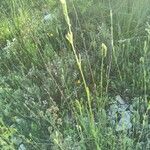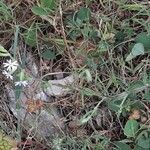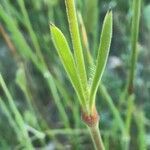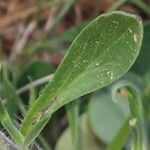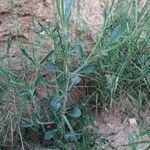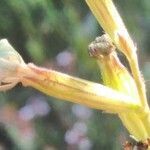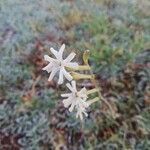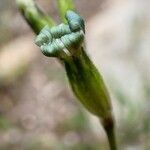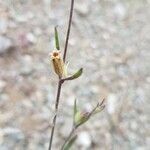Annual to 50 cm tall; stems erect, wand-like, simple or branched, 0.75-1.5 mm diam., lower parts closely puberulous with very short, spreading hairs mixed with longer hairs up to 1 mm long; upper parts of stems and inflorescences closely puberulous with very short, spreading hairs mixed with short, spreading, gland-tipped hairs. Leaves mostly basal, oblanceolate to spathulate-oblanceolate becoming oblong-lanceolate distally, 15-50 x 5-15 mm, apiculate or obtuse, base narrowed in lower leaves, ± densely pubescent with ± appressed hairs, mixed on upper leaves with gland-tipped hairs, margins towards base ciliate with hairs to 1 mm long, without evident side veins. Inflorescence a secund, spike-like monochasium terminating main stems and branches, (3-)5-8-flowered, lower flowers remote; bracts smaller than leaves, unequal, fertile bract linear to awl-shaped, densely puberulous with gland-tipped hairs mixed with acute, eglandular hairs; pedicels up to 12 mm long in lower flowers and elongating to 35 mm long in fruit, mostly 3-4 mm long in upper flowers or more rarely upper flowers subsessile, lowermost pedicels sometimes patent or deflexed in fruit. Calyx narrowly urn-shaped in flower, 9-12 x 2.0-2.5 mm at anthesis, equally 10-veined, reticulately veined in distal half, densely adpressed-puberulous with slightly longer hairs 0.5 mm long on veins, lobes narrowly triangular-lanceolate, ±2 mm long, densely ciliolate. Flowers suberect at anthesis, unscented, nocturnal or cleistogamous. Petals pink, claw 6-8 mm long, oblong but narrowed below, without auricles, limb bifid or emarginate, 1.5-4.0 x 1.5-4.0 mm, coronal scales 0.25-0.5 mm long. Stamen filaments unequal, 5-7 mm long, shorter series shortly included, longer series shortly exserted. Ovary pyriform, ± 4 mm long; styles ± 2 mm long, deeply included. Capsule ovoid, 6-8 x 4 mm, ± 4-5 x longer than carpophore, minutely transversely rugulose; carpophore ± 1.5-2 mm long, pubescent. Seeds 0.5-1.0 mm, reniform with hilar notch, reddish brown, face excavate-auriculate, testal cells radially elongated-fusiform, colliculate, back broad with narrow, tuberculate groove.
More
Herb, annual, glandular-pubescent. Stems erect, simple or branched, 10–60 cm high. Leaves appressed-pubescent, ciliate, 10–55 mm long, 3–12 mm wide; basal leaves shortly petiolate, obovate-spathulate, with petiole to 10 mm long; cauline leaves sessile or subsessile, lanceolate-obtuse. Inflorescence simple or sparsely branched, racemose, few to many-flowered; bracts herbaceous. Pedicels 2–10 mm long, hairy, sometimes glandular. Calyx narrowly ovoid, 6–13 mm long, accrescent in fruit, 10-veined, eglandular-hairy; veins green or purplish, reticulate; calyx lobes triangular to acuminate, much shorter than tube. Petal limb c. 1.5 mm long, pink, bifid. Styles 3. Capsule ovoid-cylindrical, 5–11 mm long, opening by 6 teeth; carpophore 0.5–2 mm long, ± puberulent. Seeds reniform, 0.7–0.8 mm long, greyish red; faces deeply concave; rim very broad, not winged, acutely tuberculate only in the shallow groove, blunt elsewhere.
Shortly hairy annual to 45 cm. Leaves oblanceolate, ciliate. Flowers in subsecund, spike-like, monochasial cymes, white to pink, sometimes ± cleistogamous, calyx shortly hairy, 7-10 mm long, petals bifid, carpophore ± 1 mm long.
